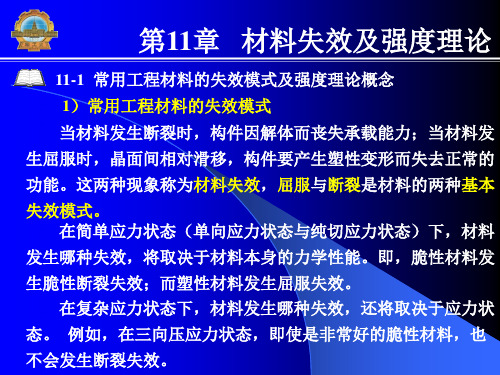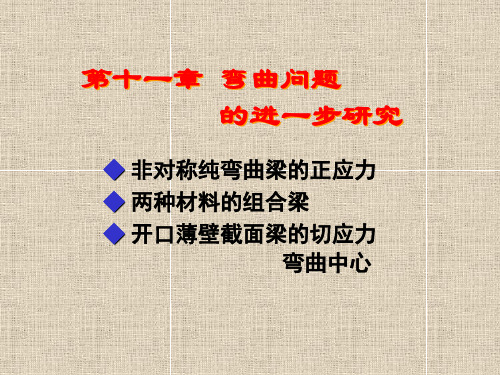【材料力学】Chapter_11-98
- 格式:pdf
- 大小:514.79 KB
- 文档页数:18






第11章典型习题解析1.用卡氏第二定理求图12.3所示刚架A 截面的位移和B 截面的转角。
略去剪力Q 和轴力N 的影响,E Ⅰ为已知.解:(1)A 截面的位移AB 段弯矩:M(x)=-Px (0≤x ≤l ) ∂M(x) /∂P=-x在A 处虚加一水平力向右的力Q,之后,再令其为0.那么,BC 段弯矩:M(y)=-2P l - Q l +(P+Q)y∂M(y) /∂P=-2l +y ∂M(y) /∂ Q=-l +yA 截面的竖直位移:Y A ==∂∂∑⎰EI P Mdx ML 0 ()()()()⎰⎰+-+-+--L LEIdy y L Py PL EI dx x Px 00222 =EIPL 223A 截面的水平位移: X A =EI Q M M L ∂∂∑⎰0dx=()()EI dy y L Qy Py QL PL L 200+-++--⎰ 积分,令Q=0得 ()()EIPL EI dy y L Py PL XA L 1252230=+-+-=⎰(2)B 截面的转角在B 处虚加一力偶M B,AB 段弯矩:M(x)=-Px (0≤x<l )BC 段弯矩:M(y)=-2P l -B M +Py (0<y<l )∂M(x) /∂MB=0 ∂M(y) /∂MB =-1 ∑⎰∂∂=L B B EI dx M M M 0θ =()()⎰-+--L B EI dxPy M PL 0212 EIPL 432= 2.用卡氏第二定理求图示的A 截面的位移和B 截面的转角。
略去剪力Q 和轴力N 的影响,E Ⅰ为已知。
解:(1)A 截面的位移在A 点虚加一向下的力F ,支反力2qL F P Y B ++= (L 为AB 和AD 的长度) P X qL P Y C C -=--=,2AB 段弯矩: M1=0∂ M1 /∂F=0AD 段弯矩:M2(x)=2qL P F qx 2++⋅1()x-2∂M2(x) /∂F=xCD 段弯矩:M3(y)=PyaⅠⅠ2ⅠC DA 截面的竖直位移:∑⎰∂∂=L A EIdx F M M Y 0=⎰⋅⎥⎦⎤⎢⎣⎡-⋅⎪⎭⎫ ⎝⎛++L EI xdx qx x F qL P 02222 积分,令F=0得34A PL qL Y 6EI 24EI =+求A 截面的水平位移时, 在A 处虚加一水平力向右的力Q, 再令其为0.那么, 支反力B qL Y P Q 2=++ (L 为AB 和AD 的长度)C C qL Y P Q X P Q 2=-+=-+()+,() AB 段弯矩: M1=0∂ M1 /∂Q=0AD 段弯矩:M2(x)=(P+Q)x ⋅∂M2(x) /∂Q=xCD 段弯矩:M3(y)=(P+Q )y∂M3(y) /∂Q=yA 截面的水平位移∑⎰∂∂=L A EI dx Q M M X 0=()⎰⋅+L EIdx x Q P 022=()⎰⋅+L EI ydy y Q P 0积分,令Q=0得 EIPL X A 23= (2) B 截面的转角在B 处虚加一顺时针的力偶M B, 积分,并令其为零。
1Chapter 11 Columns 11.1 Introduction Types of failure : fracture, buckling, fatigue, creep rupture etc., it depends on materials, kind of loads, condition of supports another type of failure is buckling, consider specifically for columns if a compression member is relatively slender, it may fail by bending or deflecting laterally rather than by direct compression of the material buckling may occurs in column, cylindrical walls etc.
11.2 Buckling and Stability consider a structure consists of two rigid bars AB and BC, pinned at B with a rotational spring having stiffness k 2
in the idealized structure, the two bars are perfectly aligned and the axial load P has its line of action along the longitudinal axis, the spring is unstressed and the bars are direct compression now suppose the structure is disturbed by some external force, the rigid bars rotate a small angle and a moment develops in the spring when the disturbing force is removed, if P is relatively small, the structure will return to its initial straight position, it is said to be stable, is P is large, the lateral displacement of point B will increase and the bars will rotate through larger and larger until structure collapses, the structure is said to be unstable the transition between the stable and unstable conditions of the axial load known the critical load Pcr
consider the bar BC, the moment MB is due to the rotation of
the spring, then MB = 2 k
equilibrium of moment at point B, (for small ) L MB - P (CC) = 0 2
P L (2 k - CC) = 0
2
the solutions are = 0 ==> perfectly straight 4 k Pcr = CC ==> critical load
L
the stability of the structure is increased either by increasing its stiffness or by decreasing its length 3
if P < Pcr, the structure is stable if P > Pcr, the structure is unstable
if P = Pcr, the structure is in neutral
equilibrium point B is called a bifurcation point
the three equilibrium conditions are analogous to those of a ball placed upon a smooth surface as shown
11.3 Columns with Pinned Ends consider a slender column with perfectly straight and is made of a linear elastic material (ideal column)
if P small, = P / A it is in stable equilibrium 4
if P is gradually increased, it will reach a condition of neutral equilibrium, the corresponding load is called critical load Pcr
if P is higher, the column is unstable any may collapse by buckling
if P < Pcr, the column is in stable equilibrium in the straight
position if P = Pcr, the column is neutral equilibrium either the
straight or a slightly bent position if P > Pcr, the structure is in unstable equilibrium in the
straight position and will buckle under the slightest disturbance actual columns do not behave in the idealized manner because imperfections always exists
to determine Pcr, we will use the second-order differential equation
in terms of bending moment M, the moment-curvature equation is E I v" = M moment equilibrium at point A, we obtain M + P v = 0 or M = - P v the differential equation of deflection now becomes E I v" + P v = 0 it is a homogeneous linear differential equation with constant coefficients 5
let k2 = P / E I then v" + k2 v = 0 the general solution of this equation is v = C1 sin kx + C2 cos kx with boundary conditions v(0) = v(L) = 0 v(0) = 0 => C2 = 0
then v = C1 sin kx v(L) = 0 => C1 sin kL = 0 case 1. C1 = 0 that means the column remains straight for any
value of kL, that is P may also have any value (this is known as the trivial solution)
case 2. sin kL = 0 => kL = 0, 2, ……, n ∵ k2 = P / E I
kL = 0 => P = 0 it is not of interest for kL = n with n = 1, 2, 3, …… the corresponding values of P are n2 2 E I
P = CCCC n = 1, 2, 3, …… L2
for this values of P, the column may have bent shape, for other 6
value of P, C1 must equal 0 (column remains straight) the equation of the deflection curve now becomes
nx v = C1 sin kx = C1 sin CC n = 1, 2, 3, ……
L
the lowest critical load for a column with pinned ends is obtained when n = 1 2 E I
Pcr = CCC
L2
the corresponding buckled shape (mode shape) is v = C1 sin x/L (1st mode)
buckling of a pinned-end column in the first mode (n = 1) is called fundamental case the critical load for an ideal elastic column is also known as the Euler Load, the bifurcation point B occurs at the critical load for x = L / 2 sin x/L = 1 v = C1
thus C1 = v(L/2) is the midpoint deflection
for n = 2 Pcr(n = 2) = 4 Pcr(n = 1) Pcr ~ n2